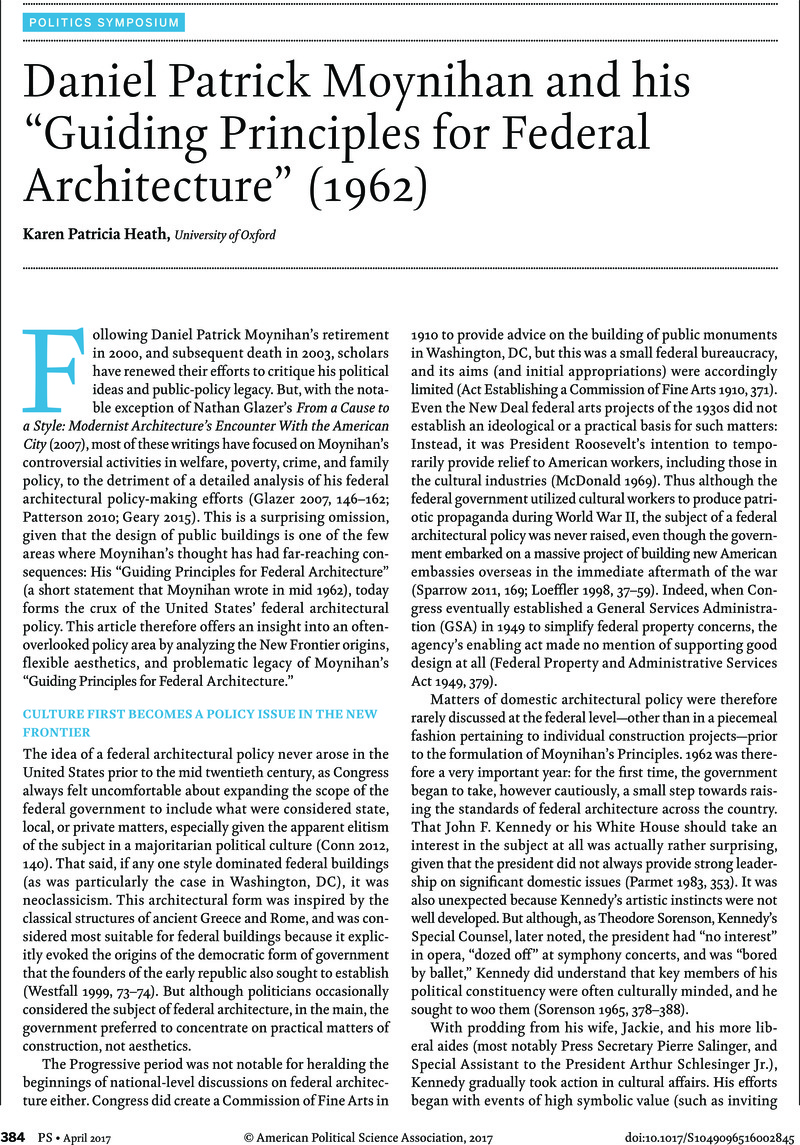No CrossRef data available.
Article contents
Daniel Patrick Moynihan and his “Guiding Principles for Federal Architecture” (1962)
Published online by Cambridge University Press: 31 March 2017
Abstract
An abstract is not available for this content so a preview has been provided. Please use the Get access link above for information on how to access this content.

- Type
- Symposium: Daniel Patrick Moynihan’s America: The Legacies of a Professor–Politician
- Information
- Copyright
- Copyright © American Political Science Association 2017
References
REFERENCES
Act Establishing a Commission of Fine Arts (May 17, 1910). 1911. Statutes at Large. 36 (1). Washington, DC. US Government Printing Office.Google Scholar
Barnhisel, Greg. 2015. Cold War Modernists: Art, Literature, and American Cultural Diplomacy, 1946–1959. New York. Columbia University Press.Google Scholar
Conn, Steven. 2012. “Culture for the People: How Government has Fostered the Arts and Culture.” In To Promote the General Welfare: The Case for Big Government, ed. Conn, Steven. Oxford. Oxford University Press.Google Scholar
Federal Property and Administrative Services Act (June 30, 1949). 1950. Statutes at Large. 36 (1). Washington, DC. US Government Printing Office.Google Scholar
Garment, Leonard. 1997. Crazy Rhythm: My Journey From Brooklyn, Jazz, and Wall Street to Nixon’s White House, Watergate, and Beyond … New York. Random House.Google Scholar
Geary, Daniel. 2015. Beyond Civil Rights: The Moynihan Report and its Legacy. Philadelphia. University of Pennsylvania Press.Google Scholar
General Services Administration. 1962. Annual Report of the Administrator of General Services. Washington, DC. US Government Printing Office.Google Scholar
Giglio, James N. 1991. The Presidency of John F. Kennedy. Lawrence. University Press of Kansas.Google Scholar
Glazer, Nathan. 2007. From a Cause to a Style: Modernist Architecture’s Encounter With the American City. Princeton. Princeton University Press.Google Scholar
Hess, Stephen. 1997. “Daniel Patrick Moynihan: The Federal Executive.”
Society
35 (1): 53–57.Google Scholar
Hodgson, Godfrey. 2000. The Gentleman from New York: Daniel Patrick Moynihan: A Biography. Boston, Houghton Mifflin.Google Scholar
Hudson, Hugh D. 1994. Blueprints and Blood: The Stalinization of Soviet Architecture, 1917–1937. Princeton. Princeton University Press.Google Scholar
Kennedy, John F. 1961. “City Upon a Hill Speech (January 9, 1961).” Miller Center. http://millercenter.org/president/kennedy/speeches/speech-3364
Google Scholar
Loeffler, Jane C. 1998. The Architecture of Diplomacy: Building America’s Embassies. New York. Princeton Architectural Press.Google Scholar
McDonald, William Francis. 1969. Federal Relief Administration and the Arts: The Origins and Administrative History of the Arts Projects of the Works Progress Administration. Columbus. Ohio State University Press.Google Scholar
Moynihan, Daniel Patrick. 1962. “Guiding Principles for Federal Architecture (June 1, 1962)”. General Services Administration. http://www.gsa.gov/portal/content/136543
Google Scholar
Parmet, Herbert S. 1983. JFK, The Presidency of John F. Kennedy. New York. The Dial Press.Google Scholar
Patterson, James T. 2010. Freedom Is Not Enough: The Moynihan Report and America’s Struggle Over Black Family Life: From LBJ to Obama. New York. Basic Books.Google Scholar
Peck, Robert A. 1998. “Daniel Patrick Moynihan and the Fall and Rise of Public Works”. In, Daniel Patrick Moynihan: The Intellectual in Public Life, ed. Katzmann, Robert A.. Washington, DC/Baltimore. Woodrow Wilson Center Press/Johns Hopkins University Press.Google Scholar
Sparrow, James T. 2011. Warfare State: World War II Americans and the Age of Big Government. Oxford. Oxford University Press.Google Scholar
Steinfels, Peter. 2013. The Neoconservatives: The Origins of a Movement. New York. Simon & Schuster.Google Scholar
Westfall, Carroll William. 1999. “Architecture and Democracy, Democracy and Architecture”. In, Democracy and the Arts, ed. Melzer, Arthur M., Weinberger, Jerry and Richard Zinman, M.. Ithaca. Cornell University Press.Google Scholar
Wetenhall, John. 1989. “Camelot’s Legacy to Public Art: Aesthetic Ideology in the New Frontier.”
Art Journal
48 (4): 303–308.Google Scholar




